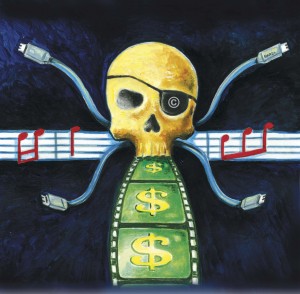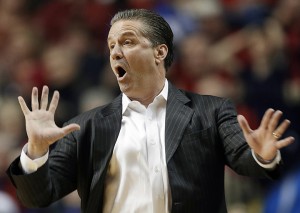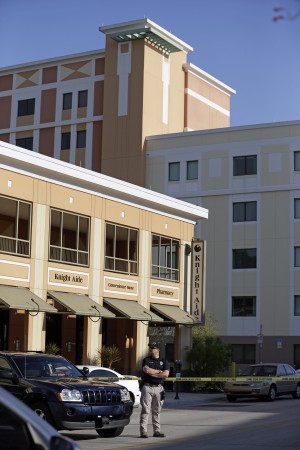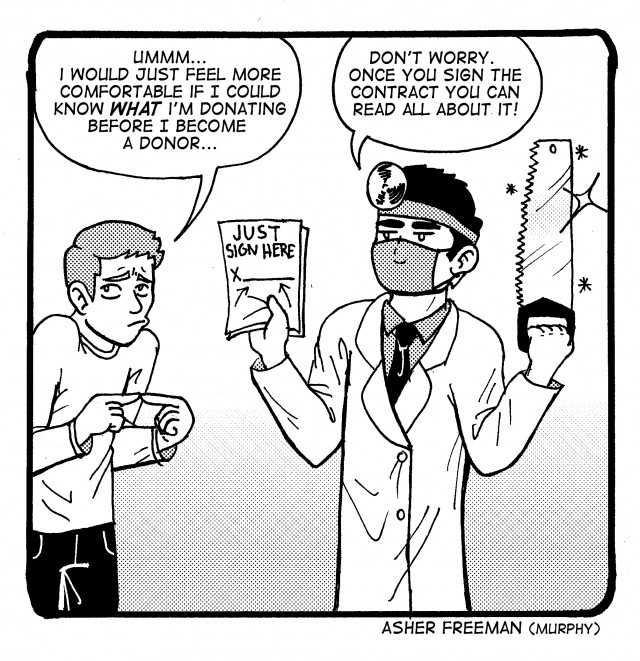
Greg (@GregDeVries3000) and Daniel (@D_Hill80) give their Final Four picks and tell you what teams they expect to do well in the NCAA Tournament. Follow the show on Twitter (@DFTBPodcast) and like us on Facebook.

Greg (@GregDeVries3000) and Daniel (@D_Hill80) give their Final Four picks and tell you what teams they expect to do well in the NCAA Tournament. Follow the show on Twitter (@DFTBPodcast) and like us on Facebook.
Diane Gottsman will present a professional networking dinner at 6 p.m. March 25 in the Barfield Drawing Room of the Bill Daniel Student Center. Students will learn professional dining and etiquette skills and get the chance to network with recruiters. The registration fee is $5. For more information and to register, visit
www.hireabear.com.
By Phillip Ericksen
Reporter
Applications are now available to join student government elections. They can be found at www.Baylor.edu/sg and are due by 5 p.m. March 28. Applications are also available in the student government office in the first floor of the Student Union Building. Applications can be turned in to the student government office.
“It’s a great way to represent the students,” San Antonio junior senator Stephen Bell said. “It’s given me a great opportunity to represent my fellow classmen, as well as to work with administration to find common ground on issues pertaining to student needs.”
Student government also provides an opportunity for students to come together while serving the greater student body. All students are eligible to apply.
As stated in the Student Body Constitution, officer duties include acting as a spokesperson to students and helping plan projects.
“It’s given me a platform to voice my views and to voice my constituents’ views,” San Antonio junior senator Grant Senter said. “Student government gives you the chance to voice other students’ opinions to build a better Baylor and to build a better Waco.”
All student body, senate and class officer positions are open for applications. For more information on any of the positions, refer to the Student Body Constitution.
“I really encourage everyone to give it a try,” Bell said. “This is an exciting time for Baylor.”

By Colleen Long
Associated Press
NEW YORK — Many of the tens of thousands of New Yorkers stopped, questioned and sometimes frisked by police in the past decade were wrongly targeted because of their race, lawyers for four men who claim they were illegally stopped said Monday.
But New York Police Department lawyers countered that officers must go where the crime is — and the crime is overwhelmingly in minority neighborhoods.
A civil trial that began Monday in federal court in Manhattan will examine the police tactic that has become a city flashpoint, with mass demonstrations, City Council hearings and mayoral candidates calling for change. The lawsuit, now a class-action, seeks a court-appointed monitor to oversee changes to how the police make stops.
The courtroom and overflow rooms were packed Monday, and stop-and-frisk opponents held an afternoon rally outside the courthouse. The Rev. Jesse Jackson watched the opening statements, telling reporters outside court afterward: “I heard rationalization and justification rather than explanation from the city. They were not denying. They were justifying.”
The trial is expected to last more than a month.
The mayor and police commissioner say stop-and-frisk is a life-saving, crime-stopping tool that has helped drive crime down to record lows.
But Darius Charney, the lawyer for the four men who filed the suit in 2008, said the department is doing stops illegally and must make adjustments. He called many of the stops a “frightening and degrading experience” for “thousands if not millions” of New Yorkers.
Charney, of the Center for Constitutional Rights, called the stops “arbitrary, unnecessary and unconstitutional,” and promised that plaintiffs will show the judge “powerful testimonial and statistical evidence” that New Yorkers are routinely stopped without suspicion.
Police have made about five million stops in the past decade, of mostly black and Hispanic men. Two witnesses testified Monday, out of a dozen who say they were targeted because of their race.
One, Devin Almonor, the 16-year-old son of a police officer, said he was thrown against an unmarked car and handcuffed when he was 13 on his way home. The other, David Floyd, testified that he was wrongly stopped twice. Both said they were testifying because they didn’t want the same injustice to happen to other people. Floyd, 33, is now a medical school student.
City lawyers sought to discredit the witnesses by suggesting their stories had evolved over the years to become more dramatic.
Officers and criminologists who have studied the statistics on street stops are also slated to testify, and lawyers plan to play hours of audio tapes made by Adrian Schoolcraft, an officer who was hauled off to a psych ward against his will after he said he refused to fill illegal quotas.
U.S. District Court Judge Shira Scheindlin, who has said in earlier rulings that she is deeply concerned about stop-and-frisk, is not being asked to ban the tactic, since it has been found to be legal. But she does have the power to order reforms, which could mean major changes to the nation’s largest police force and other departments.
City lawyers said Monday the department already has many checks and balances, including an independent watchdog group that was recently given authority to prosecute some excessive force complaints against police. Officers have more than 23 million contacts with the public, make 4 million radio runs and issue more than 500,000 summonses every year.
Comparatively, 600,000 stops annually are not unreasonable, city attorneys said.
“The New York Police Department is fully committed to policing within the boundaries of the law,” said Heidi Grossman, an attorney for the city. “Crime is not distributed evenly across the city.”
The city lawyers said the expert testimony was flawed and evidence would show a correlation between the description of suspects and those stopped.
“Police are given an awesome responsibility, one of which is to bring crime down and keep people safe,” Grossman said.
Street stops have risen dramatically since the 1990s while overall crime dropped in a city that once had the highest murder rate in the nation. Mayor Michael Bloomberg and Police Commissioner Raymond Kelly say the stops are a deterrent that led to lower crime.
The city recorded 419 murders in 2012, down from more than 2,000 in the 1990s and the lowest since similar record-keeping began in the 1960s.
More than 531,000 people were stopped last year, more than five times the number when Bloomberg took office a decade ago. Fifty-one percent of those stopped were black, 32 percent Hispanic and 11 percent white. According to census figures, the city has 8.2 million people: 26 percent are black, 28 percent are Hispanic and 44 percent are white.
About half the people who are stopped are subject only to questioning. Others have their bag or backpack searched. And sometimes police conduct a full pat-down. Only 10 percent of all stops result in arrest, and a weapon is recovered a small fraction of the time.
Recent polls show a stark divide over how blacks and whites view the tactic, while among Hispanics, disapproval of the practice has grown.

Associated Press
MINNEAPOLIS — A Minnesota woman at the center of a long-running court fight over the unauthorized downloading of copyrighted music said there’s still no way she can pay record companies the $222,000 judgment she owes after the U.S. Supreme Court declined to hear her appeal Monday.
The justices did not comment on their decision. Attorneys for Jammie Thomas-Rasset, of Brainerd, argued the amount was excessive.
The music industry filed thousands of lawsuits in the early to mid-2000s against people it accused of downloading music without permission and without paying for it. Almost all the cases settled for about $3,500 apiece. Thomas-Rasset is one of only two defendants who refused to pay and went to trial. The other was former Boston University student Joel Tenenbaum, who also lost and was ordered to pay $675,000.
The industry initially sued Thomas-Rasset in 2006. Since then, her case has gone through three trials and several appeals. The industry presented evidence that Thomas-Rasset made available over 1,700 songs to other computer uses via the file-sharing service Kazaa, though the lawsuit targeted only 24 songs.
“I’m assuming that since they declined to hear the case it’s probably done at this point,” she said. But she also said she needed to consult with her attorneys to determine what happens next.
Thomas-Rasset, 35, who works for the Mille Lacs Band of Ojibwe tribal government, maintained — as she has all along — that she can’t afford to pay.
“There’s no way that they can collect,” she said. “Right now, I get energy assistance because I have four kids. It’s just the one income. My husband isn’t working. It’s not possible for them to collect even if they wanted to. I have no assets.”
Thomas-Rasset added that she became a grandmother in June.
The Recording Industry Association of America offered to settle for $5,000 when it first sued, and offered to settle for a $25,000 donation to a charity for music industry people in need after her second trial. She refused both times.
“We appreciate the Court’s decision and are pleased that the legal case is finally over,” the trade group said in a statement. “We’ve been willing to settle this case from day one and remain willing to do so.”
Thomas-Rasset’s attorney, Kiwi Camara, of Houston, expressed disappointment in the outcome but hinted in an email that the legal options may not have run out. He noted that Tenenbaum’s case remains live before the 1st U.S. Circuit Court of Appeals. Tenenbaum is still challenging the size of the judgment against him. His attorneys, including Camara, argue that it’s “grossly disproportionate” to his offense.
The case is Thomas-Rasset v. Capitol Records, 12-715.

By Steve Megargee
Associated Press
Frustrated Southeastern Conference coaches say their league is treated more like a mid-major rather than a BCS conference.
The coaches said Monday the perception all year has been that the SEC was having a down year. The NCAA tournament selection committee apparently felt it was more than perception.
Florida, Missouri and Mississippi earned the SEC’s only three NCAA berths, the fewest of any of the six major conferences. The SEC also ranked below the Atlantic 10 and Mountain West, which earned five bids each.
The SEC also sent only three teams to the tournament in 2009. Before then, the SEC hadn’t received as few as three bids since 1990.
One of the “things that hurt us was the impression the league’s down,” Kentucky head coach John Calipari said. “Everyone seems to say it. That’s why I tell the coaches we’ve got to brag about each other. We’ve got to set that straight.”
The three berths continue the SEC’s downward trend.
Kentucky, the defending national champion, tied for second place in the SEC with Alabama and Mississippi. Kentucky and Alabama still ended up in the NIT. Mississippi only got a No. 12 seed in the NCAA field after winning the SEC tournament.
Tennessee head coach Cuonzo Martin predicted two weeks ago that the SEC would earn six bids to the Tournament.
Martin said the SEC’s three bids were an “embarrassment” after the brackets were revealed, and he didn’t back down from those comments Monday. He said Tennessee, Kentucky and Alabama are “NCAA tournament teams” that landed in the NIT.
“It’s almost like a mid-major mentality in this league, when you’ve got your second-place team that doesn’t get in the NCAA tournament,” Martin said. “This is a BCS league. It’s one of the best leagues in America. That shouldn’t happen.”
The SEC’s non-conference performance indicates it actually wasn’t one of the best leagues in the nation this season.
SEC schools went a combined 15-33 against the other five major conferences and had losing records against each of them: 3-6 against the Atlantic Coast Conference, 2-5 against the Big 12, 4-13 against the Big East, 2-4 against the Big Ten, 4-5 against the Pac-12.
More players were taken in the NBA draft from SEC schools than any other conference last year.
Tennessee forward Jeronne Maymon, one of only two returning all-SEC players from last season, missed the entire year with a knee injury.
Kentucky center Nerlens Noel was challenging for SEC player of the year honors before tearing the anterior cruciate ligament in his left knee last month. LSU, Mississippi State and South Carolina had new coaches.
“When you have coaching changes, when you have player turnover, when you have departures of really good players, it’s going to take some time,” Florida coach Billy Donovan said. “The unfortunate part with all those transitions going on is you really pay the price in November. … What happens is your league gets labeled in November and December.”
Donovan believes the league got better as the season wore on, but it couldn’t prove that because its members were facing one another.
But it’s tough for SEC teams to schedule non-conference foes later in the year, particularly now that it has adopted an 18-game league schedule.
If SEC teams don’t schedule quality non-conference foes later in the season, they must deliver better results against better teams early in the year.
Five of the SEC’s 14 teams ranked lower than 230th in non-conference strength of schedule. Not only did the SEC schedule weak teams, it occasionally lost to them.
Mississippi State fell to Alabama A&M, a Southwestern Athletic Conference team that finished 11-20. Vanderbilt lost to Marist, a Metro Atlantic Athletic Conference program that went 10-21.
The importance of non-conference performance was apparent from the fact that Missouri earned a bid despite getting the No. 6 seed in the SEC tournament. Missouri beat NCAA tournament participants Illinois and VCU at neutral sites early in the season.
“What happens with mid-major teams is they schedule aggressively because they know the best-case scenario to get into the NCAA tournament is you’ve got to go play teams,” Martin said. “So maybe we need to schedule like mid-major teams.”
SEC coaches realize they must do something to stop the conference’s declining total of NCAA bids. Their futures could depend on it.
“At the rate we’re going, if we don’t get it corrected, in some way, shape or form, you’re looking at three different new (coaches) every year” in the conference , Martin said. “Something has to give.”

By Alexa Brackin
News Editor
RodeoHouston contestants in seven categories roped up $1.68 million in prize money in the BP Super Series of the 2013 show that took place from Feb. 25 to Saturday.
The infamous RodeoHouston BP Super Series is an invitation-only, international event that features the top 40 cowboys and cowgirls in seven events in five three-day series; tie-down roping, bareback riding, team roping, saddle bronc riding, steer wrestling, barrel racing and bull riding.
This rodeo is unlike most others because contestants do not pay entry fees; the purse is provided entirely by RodeoHouston. Along with a pretty paycheck of more than $50,000, all the winners walked away with a trophy saddle and a champion belt buckle. The rodeo also offered the RodeoHouston Super Shootout, on March 9, which is a one-day event that features only the champion athletes from 10 of the best rodeos in the United States and Canada. The event is the richest one-day rodeo in the world. With a total purse of $200,000, it sent each winner home with $25,000 and a champion buckle.
The Houston Livestock Show and Rodeo, which handed out more than $2 million in total winnings this year, is the final leg of the Texas rodeo trio that includes the San Antonio Stock Show and Rodeo and the Fort Worth Stock Show and Rodeo.


Associated Press
ORLANDO, Fla. — A University of Central Florida drop-out planned an attack on campus but committed suicide in a dorm before carrying it out, authorities said Monday.
Materials found in his dorm room made it appear that 30-year-old James Oliver Seevakumaran planned a wider attack, authorities said in a news conference.
Seevakumaran pulled a gun on another student, who then called police, said University of Central Florida Police Chief Richard Beary. He then killed himself with a shot to the head moments later as police officers were responding to the call.
“His time line got off,” Beary said. “We think the rapid response of law enforcement may have changed his ability to think quickly on his feet.”
UCF spokesman Grant Heston said the university was in the process of removing Seevakumaran from the dorm before Monday. Four makeshift explosive devices were found in a back pack, and Beary said he believes that Seevakumaran pulled a fire alarm in the dorm to get other students out in the open for an attack.
Seevakumaran’s roommates told detectives that he had shown anti-social behavior but had never expressed any violent tendencies, Beary said.
According to Florida records, his only adult arrest in the state was in 2006 for driving with a suspended license.
He pleaded no contest. He was fined $105 and assigned court costs of $223.
University police were called to the Tower I building around 12:20 a.m. after a fire alarm went off. Around the same time, the 911 call came in about a man with a gun.
Investigators said they discovered two guns and the makeshift explosives in the room where Seevakumaran was found dead.
About 500 students were evacuated from the building and morning classes were canceled.
 One of the most stressful parts of the semester is registering for classes.
One of the most stressful parts of the semester is registering for classes.
Registering has several parts: first you meet with your adviser, or advisers if you’re in certain programs, then you must stalk Bearweb carefully to see what times and professors are available for the classes you need. Maybe you check out the reputation of your potential professors online at sites like ratemyprofessors.com.
Once you hammer out your perfect schedule and register, it should be smooth sailing from there, right?
Wrong.
Although brief descriptions are offered for classes prior to registration, students don’t have access to anything like a syllabus before the semester starts. There is nothing more frustrating than taking all this time to sift through the thousands of classes and sections of classes that Baylor offers only to get into class the first day and find out the class description you saw before you started class was severely misleading.
Instructors should post syllabuses for the sections and classes they’re teaching prior to the earliest registration date so that students know what they’re getting into before they commit. That way, once the first day rolls around, there are no incompatible expectations or surprise expenses.
Because every teacher is different, this means that even intro courses are going to be different from one another. A brief, one-size-fits-all-class description can’t possibly do any course justice.
Take a basic English class, for example. Some professors will focus more on writing and require lots of essays, while others will focus on reading and discussion. Depending on a student’s learning style, he or she could excel with one of these teaching styles and crash and burn with another. It would be greatly beneficial to students if some basic syllabus was offered with each course.
Futhermore, many courses at Baylor require outside activities that take up time that many students have already devoted to other things. Because many students already dedicate their out-of-class time to work, sports, volunteering, etc., it can be hard to rearrange schedules for last-minute class requirements. The best way to prepare students is to let them know ahead of time — before the start of the semester. That way, students can alter work schedules or avoid classes that require out-of-class commitments they can’t make. A syllabus for each course posted before the start of the semester will warn students before they commit and should contain the basic requirements.
It should also warn students of any expenses not covered in the list of required texts, art supplies, for example, which can be expensive. These expenses should not be sprung on students at the beginning of the semester — not after they’ve already taken out financial aid and may need to live on a tight budget.
Letting students know what they get into beforehand can only benefit students, professors and administrators. Fewer students will need to drop courses, having a good idea of the course requirements and costs upfront. Think about it, students: You won’t have to scramble to fill the necessary hours left by a dropped course.
So please, Baylor, reconsider your system of syllabuses.
Please offer students a detailed calendar and syllabus that tell us exactly what is required in the way of course materials, outside activities and class content before we commit to a class.
This will allow students to adequately prepare for the semester and not have to scramble at the last minute to figure out how to succeed in a course they weren’t equipped for.
Sports media is dominated by ESPN. Its round-the-clock coverage on Sportscenter, paired with its engaging talk shows, such as “First Take” and “Pardon the Interruption,” constantly serves multitudes of sports fans around the world.
Though ESPN has always been my go-to channel when turning on the TV, lately it’s been disappointing.
If one were to predict before this NBA season that the largest sports conglomerate in the world would consistently cover, analyze and debate an underachieving, below-.500 team, that person would sound ridiculous.
However, that indeed is what’s been happening for months now. The Los Angeles Lakers, usually a Western Conference contender, continue to struggle mightily due to injuries, lack of team chemistry and coaching issues.
ESPN continues to devote time on Sportscenter and its other shows to the Lakers. From press conferences to player tweets, every aspect of the team’s season is discussed on a daily basis.
To the average sports fan craving a wide variety of sports coverage, constant Lakers news gets a little old, especially when other teams around the NBA see great success.
The Spurs, for example, are continuing their dominance. The Thunder are shortly behind in second place. Even the Milwaukee Bucks have better playoff chances than the Lakers. In fact, more than half of the league has better playoff chances, yet none of these teams get the media attention they deserve.
This leads us to the obvious question: Why do the Lakers get so much attention?
Los Angeles is a big media market. It’s a hotbed of Hollywood celebrities and constant drama. The team is similar.
Kobe Bryant, easily one of the best basketball players of all time, provides flashy highlights and intense competitiveness. Metta World Peace, formerly Ron Artest, is an off-the-rails character who seems to always have suspension looming.
Dwight Howard and Steve Nash are also newcomers with successful pasts and high expectations that aren’t panning out.
Their former coach, former Cavaliers coach Mike Brown, was fired after only a few games and replaced by Mike D’Antoni, an offensive guru.
Though the storylines seem countless, any other struggling, small-town team would not be getting the attention. We’ve actually seen this before from ESPN.
The New York Jets finished this season 6-10, but gained arguably the most coverage of any other team.
As with the Lakers, the combination of big market (East Rutherford) and big names (Tim Tebow, Mark Sanchez, Rex Ryan) kept the Jets constantly in the news.
There’s no stopping this trend.
Maybe Americans just like to see teams with high expectations fail.
Maybe it’s an inherent trait to anticipate losses in situations like these, and we love to constantly hear about our correctness.
All in all, I’m sure the Spurs and Thunder prefer where they stand at the ESPN headquarters in Bristol, Conn.
They remain under the radar, quietly winning games and securing prime playoff positions.
And as of now, every Lakers fan would give up even a small amount of media attention for some wins.
Phillip Ericksen is a senior journalism major from San Antonio. He is a reporter for the Lariat.
Government transparency may often seem to be an elusive ideal. Texas Comptroller Susan Combs, however, is leading the way toward achieving this goal with common-sense solutions and a bold vision.
I had an opportunity to interview Combs before she spoke on a panel at the Conservative Political Action Conference (CPAC) titled “Has Atlas Shrugged? Business in America.” “Atlas Shrugged,” a famous, influential book by philosopher Ayn Rand, describes the dangerous consequences in a society that demonizes business and financial success. John Galt, the hero, finally stands up to the oppression by starting a new society that values success and innovation.
According to Combs, while speaking on the panel, “John Galt lives in Texas.” The economic statistics certainly support her claim. Texas has cut spending, balanced the budget and still maintained a “rainy day fund” for use in critical situations.
“With what’s going on in this administration, I thought that it sounded an awful lot like the themes in ‘Atlas Shrugged,’” Combs told me. “This particular government seems to really have it in for business, seems to have it in for risk-takers, seems to have it in for people in the private sector.”
When government oppresses business and demands higher taxes, citizens have a very difficult time finding out where their money goes. Combs wants this to change.
She is fighting for a revolutionary program that will require local governments in Texas to post information online about how tax revenue is spent. Data regarding education spending, local debt obligations and public pensions will be available for all citizens to view and analyze. “My hope is that I’m going to try to raise the consciousness of every single Texan in the state to let them know that it’s your money,” she said.
This isn’t just talk. After only four days in office, Combs posted all of her own agency’s expenditures online, “down to the pencil level.” Within six months, she had done the same for all state agencies.
The first hearings on her new proposals, House Bill 14 and Senate Bill 14, took place yesterday. The leading opposition to the bills comes from local governments citing difficulties in posting the information. To dispel these criticisms, Combs is implementing innovative strategies. She incorporates the use of Facebook and offers free website design for any local government that needs help preparing the information. “It is inexcusable in 2013 that we cannot find out about every single tax dime,” she said.
With these transformative new programs, Combs hopes other states will soon follow Texas’ example. “We are leading the way in terms of transparency,” she told me. “We had 30 states contact us about how we put this up.”
Danny Huizinga is a sophomore Baylor Business Fellow from Chicago. He manages the political blog Consider Again and writes for The Washington Times Communities.
If I correctly understood the intended message of the Lariat’s editorial — “Waging War Against Piracy is Useless” on March 8 — I must vehemently disagree. Piracy may be a bad and regrettable “fact of life” but so are many social ills.
Decorum prevents my mentioning all such “facts of life” but the list would include violent crimes, robbery, racism, identity theft, bullying, and so on. Are we to stop fighting those social ills because they are “facts of life”?
For reasons that escape me, theft of intangible assets seems more “acceptable” to many, than theft of tangible property, though the effort to create the two types need not differ at all.
Imagine spending hours, weeks or years (and your own money) to produce products for sale, only to have them all stolen from your home or place of business. Would you suggest to anyone that they should not call the police about the burglary – “burglary is just a fact of life”?
I would add that the excuse of “everyone does it” only works until one is caught. I believe it irresponsible for anyone to, in essence, advocate illegal and clearly immoral activity based to any extent on such a premise.
In private practice, I represent many whose livelihoods depend on the protection of their intellectual property. I provide many such services pro bono, because some cannot afford to pay my usual fees (in part, because of piracy). The victims of piracy are real human beings, and I wish all could see them as I do in real life, with real losses, real pain, and all-too-often real failure as otherwise successful artists, inventors and authors.
Think before you pirate.
David G. Henry, Sr. J.D is a lecturer in Baylor Law School / Hankamer School of Business.
The Baylor Bears started the season ranked No. 19 in the preseason AP Top 25 poll.
The Bears went into the Big 12 Tournament as the No. 6 seed setting up a rematch with Oklahoma State. The Bears lost a heartbreaker to the Cowboys 74-72 in Kansas City at the Sprint Center. The Bears were down 42-24 at half and battled back in the second half to give Oklahoma State a run for their money. Senior point guard Pierre Jackson had a chance to win the game with a three at the buzzer but the shot deflected off the rim.
After a season that fell short of expectations, the Baylor Bears were denied a bid into the NCAA Tournament.
Rather than competing for a third Elite Eight appearance in four years, the Bears will be playing in the National Invitational Tournament this postseason.
“Nobody wants to finish playing,” Baylor head coach Scott Drew said. “To have an opportunity to play postseason means the seniors get a chance to put on that uniform one last time. And I know at the end of the year, there are only two happy teams — the one that wins the national championship in the NCAA and whoever wins the championship in the NIT. So the goal is to be one of those teams that win the last game.”
One positive aspect of being in the NIT is that Baylor will have the opportunity to host one game and possibly a second at the Ferrell Center.
At 8 p.m. Wednesday, the Bears will host Long Beach State at the Ferrell Center. The contest will be televised nationally on ESPN2.
The Bears were 18-14 overall this season and had a 9-9 record within the Big 12 Conference. The Bears’ season was filled with ups and downs.
The Bears started off the regular season with a 5-1 record before losing two of their next three in what would eventually end up being their two weakest losses of the season. The Bears lost to the College of Charleston 63-59 at home in the Ferrell Center. After the loss to Charleston, the Bears had one of their most notable wins of the season when they went into Rupp Arena and defeated the Kentucky Wildcats 64-55. Following the thrill of the Kentucky victory, the Bears lost again at the Ferrell Center when Northwestern toppled them 74-70.
Those two home losses would come back to haunt the Bears. If the Bears had won those two games, there’s a strong chance that their résumé would have qualified them for the NCAA Tournament.
Aside from the Kentucky win, the Bears’ other two wins were at home against Oklahoma State early in the Big 12 schedule and then at home again in the regular season finale against Kansas.
The highlight of the Bears’ season was beating No. 3 Kansas in the Ferrell Center by an astounding 23 points. After the Bears crushed Kansas, it seemed as if momentum was on their side and that they would make some noise in the Big 12 Conference.
Jackson, Big 12 Preseason Player of the Year, did not disappoint in his senior season for Baylor. The electrifying senior guard led the Big 12 in scoring and assists. Jackson is the first player to accomplish the feat since Jason Terry was at Arizona nearly two decades ago. Jackson is only the fifth player to ever lead a power conference in both scoring and assists.
Jackson was slighted in the opinion of many basketball fans in postseason awards. Jackson was named to the All-Big 12 second team by the coaches, and Jackson did earn First-Team All-Big 12 from the Associated Press.
Freshman center Isaiah Austin was named to the Big 12 All-Rookie team by the coaches. Austin was also named second team All-Big 12 by the media and third team All-Big 12 by the coaches. Austin averaged 13.2 points and 8.6 rebounds per game.
Junior forward Cory Jefferson had a breakout season for the Bears as he averaged 12.1 points and 8.3 rebounds per game. Jefferson was named All-Big 12 honorable mention by both the media and the coaches.
Junior guard Gary Franklin knew that the Bears season fell short of preseason expectations, but still felt that the Bears were good enough to make the NCAA Tournament.
“Absolutely, I mean I thought we did enough,” Franklin said. “Obviously, we didn’t have the season we wanted to have or expected to have but we thought we deserved to play in the NCAA Tournament so I think the only way to prove that is to win the whole thing [NIT].”
Despite the obvious disappointment of not being selected to the NCAA Tournament field of 68 teams, the Bears are relishing the opportunity to play in the NIT.
“The disappointment of not making the NCAA is always hard on everybody that’s playing in the NIT,” Drew said. “At the same time, now that you know who you’re playing and you know you do have postseason, the excitement kicks in. And everyone knows, you lose, it’s the last time you put on the jersey, so, there’s plenty of motivation and intensity, and everyone knows what’s going on.”
The NIT presents the Bears with a chance to play postseason basketball and have more home games at the Ferrell Center.
The NIT can also serve as a foundation to build toward next season’s success for Baylor and gives the squad a chance to play at the Mecca of basketball, Madison Square Garden in New York City.
“We’ve got a lot to prove still,” Jackson said. “We’ve still got five games to play and that’s a lot of basketball to show everybody that we’re good. I feel like we still belong in the big dance but it’s not about ifs and buts. I’ve never gotten a chance to play at Madison Square Garden in New York so that would be a good goal for the team.”


By Parmida Schahhosseini
Sports Writer
With March Madness upon us and spring break over, it is the time of year where everyone gets serious. Students make that final push academically for the perfect GPA before the semester ends, and basketball teams compete for the opportunity to play for a National Championship. This competition is reality for the No. 1 Lady Bears as they try to meet high expectations and advance to the Final Four round in New Orleans for a chance to win consecutive national titles.
The Final Four is April 7-9, in New Orleans Arena. New Orleans is a great location because it is a lively city with much to do. Starting April 6, there will be an event called Tourney TownTM, which is a free fan festival celebrating the best of the Final Four, located in downtown New Orleans (adjacent to New Orleans Arena). There will be a stage in the center with continuous events such as concerts by national recording artists, a talent show featuring local acts and celebrity judges, the AT&T Mascot challenge, fan contests for prizes, appearance and autograph sessions with sports celebrities, sponsor based entrainment and giveaways.
Some of the events in Tourney TownTM include the Capital One Cup Fan Zone, the AT&T Fan Zone, the Coke Zero Refreshment Court and the Allstate Good Hands Fan Zone. The Capital One Cup Fan Zone allows fans to compete in sports. The opportunity to win prizes increases the more one plays the games. On April 7, fans will also have a chance to meet Lisa Leslie, a former WNBA player and four-time Olympic gold medalist, for autographs. The AT&T Fan Zone allows people to pose for a photo with the Naismith Trophy, which is given to the best male and female players in the country. The Coke Zero Refreshment Court has sampling stations, the Coke Zero 3-point competition, temporary tattoos and the opportunity to pick up some Coke Zero mardi gras beads. The Allstate Good Hands Fan Zone has other activities including a competition to see who has the fastest 40-yard dash.
A visit to New Orleans doesn’t need to be limited to Tourney Town. New Orleans is a city with scenic charm. An obvious place to visit is the French Quarter, which is the cultural center of New Orleans. People can sight see, shop and dine. Jackson Square is also located inside the French Quarter as it is filled with the arts. Jugglers, musicians and artists fill the streets for constant entertainment as one explores the scenery around them. The St. Louis Cathedral is another major landmark that people can visit. The art and design is something that is worth seeing because it’s like no other. Bourbon Street has a great nightlife with jazz and country western songs that fill the air. People can shop and enjoy some Cajun food as well.
“New Orleans has cultural benefits to offer interested visitors that they will find nowhere else”, says Mark Romig, President and CEO of New Orleans Tourism Marketing Corporation.” In addition to some five dozen museums and house museums, you will find our culture in music clubs on Bourbon and Frenchman streets; in our artful and unique cuisine at both fine dining and neighborhood restaurants; and by riding through our city to look at the beautiful historic architecture.”
While it is not as well known, Frenchmen Street is for people who want to try something new. Frenchmen Street has colorful buildings and great jazz music, but it is less crowded than Bourbon Street. The great music is what Frenchmen Street is known for, but people come to enjoy great food and listen to the music in the moonlight.
While spending time in New Orleans it’s hard not to develop a sweet tooth. La Boulangerie is a French bakery, which offers authentic pastries and other treats. The place has character, making it memorable not just for the food, but for the environment as well.
“First and foremost I recommend the croissants and the French bread,” Kylee Countrymen a worker from La Boulangerie said. “Honestly everything is good including the pastries.”
However, people must be willing to deal with the long lines and limited parking before enjoying the pastry.
Other highly rated restaurants according to consumers on TripAdvisor include Zea Rotisserie & Grill, Verti Marte, The Joint and Louisiana Pizza Kitchen. Louisiana is known for its Cajun food, so here are some highly rated restaurants: Mr. B’s Bistro, Liuzza’s by the Track and Louisiana Bistro. Prices do vary depending on where one goes to eat.
While the most important event may be the Final Four, there is time for people to enjoy other aspects of New Orleans along the way.
 By Greg DeVries and Larissa Campos
By Greg DeVries and Larissa Campos
Sports Editor and Reporter
Compete is a word very familiar to head women’s basketball head coach Kim Mulkey. In high school, she led her Hammond High School basketball team to four consecutive state championships. She then went on to play point guard at Louisiana Tech University and won two National Championships, the AIAW title in 1981 and the inaugural NCAA title in 1982. When it came to sports, Mulkey knew how to compete.
But her competitive nature began off the basketball courts and ball fields. She discovered her intense desire to win and be the best in the classroom.
“Every test you take you want to make an A,” Mulkey said. “I knew that I wasn’t the smartest kid in the school or even in the classroom but I knew I could out study them.”
Mulkey’s will to compete in the classroom earned her a perfect 4.0 GPA and the honor to represent her class as valedictorian at Hammond High School.
Mulkey didn’t grow up in a home where she was pushed to succeed in academics. Her parents were high school graduates and worked hard to support their family. The will and determination to do well in school came completely from her desire to win and beat out her classmates.
“I graduated valedictorian and certainly was not the smartest kid in the school,” Mulkey said. “I probably had the worst ACT score out of anybody in the top ten but my competitiveness allowed me to surpass them when it came to taking tests.”
After high school, Mulkey continued these study habits in college at Louisiana Tech University while playing for the Lady Techsters.
As a player, Mulkey was an All-American point guard that helped her team earn two National Championships, one AIAW Championship in 1981 and one NCAA Championship in 1982. Two years later, Mulkey competed on the USA Women’s basketball team in the 1984 Summer Olympics in Los Angeles and helped the Americans win a gold medal.
As a student, she graduated Suma Cum Laude with a business degree and was on her way to conquering the corporate world after college.
Being a basketball coach wasn’t even a passing thought for Mulkey as she finished school. She always had plans to graduate and get into the business world right away. However, after participating in the Olympics she was given the opportunity to further her education at Louisiana Tech with a Masters in business degree.
“Back then the NCAA gave five female and five male basketball players a check to go work on their post graduate studies and I was one of those who was fortunate enough to get it,” said Mulkey.
Mulkey has used her competitiveness not only to win games and championships but also to make sure all her players get a college education.
“As a coach, she places a great importance on academics and makes it her personal goal to make sure all of her players graduate,” sophomore Mackenzie Robertson said. “She really wants us to become better people in life, not just basketball.”
Her future plans in the business world took a major turn one day when she was sitting in class. A group of police officers entered the classroom and asked the professor to have Kim Mulkey meet them outside after class was over.
“I was nervous because you start thinking there was a death in the family or there’s been a horrible accident, but what it was, the president of the university sent them.” Mulkey said. “The head women’s coach at the time was Sonja Hogg had retired and the president wanted me to be on the women’s basketball staff under the new head coach, Leon Barmore. I went up to his office and he convinced me to give it a shot.”
The decision to take this coaching position was one that would alter her life forever as she would go on to make history as a coach in women’s basketball throughout her career.
During her tenure as an assistant coach, Mulkey had head coaching offers from schools like Missouri, South Carolina and Texas A&M, but she wanted to stay loyal to Louisiana Tech.
After achieving the highest winning percentage in the history of women’s basketball, Barmore retired and left the program to Mulkey.
During contract negotiations, Mulkey had her heart set on a five-year deal. Louisiana Tech, however, had a shorter agreement in mind. Despite Mulkey’s begging and pleading, Tech would not budge, and Mulkey accepted Baylor’s five-year offer and moved to Waco.
Since then, Mulkey has coached her teams to five Big 12 Championships, including three in a row from 2009-2013, and two National Championships. She has been named the Big 12 Coach of the Year four times and has earned USBWA National Coach of the Year honors in both 2011 and 2012.
Mulkey is already a member of the National High School Hall of Fame, the Louisiana High School Hall of Fame, the Louisiana Sports Hall of Fame and the Louisiana Tech Athletics Hall of Fame.
Another national championship this year would add to the numerous successes and achievements that have helped cement her as one of the game’s all-time greats.
By Greg DeVries
Sports Editor
Anyone that has been to a Baylor Lady Bears basketball game has seen the video that plays before player introductions. Head coach Kim Mulkey stands before her players and talks about the expectation that this team will repeat as National Champions.
Those are some pretty lofty expectations, but that’s where this team is. If the Lady Bears don’t win the National Championship, then this season has been a failure. It may be harsh. It may even be unfair, but it only speaks to how much this team has accomplished and how talented it is. Big 12 regular-season championships and Big 12 Tournament championships are nice, but for Mulkey and the Lady Bears, those trophies may as well be paperweights when the real goal is a National Championship.
The senior class consisting of center Brittney Griner, guard Kimetria Hayden, guard Jordan Madden, forward Brooklyn Pope and forward Destiny Williams has earned this expectation. Back-to-back National Championships will be the best way to end the Griner Era in Lady Bears basketball history.
Over the last three seasons, the Lady Bears are 106-4. This run has included three Big 12 Championships, an Elite Eight appearance, and most importantly, a National Championship.
This recent success has put the Lady Bears in a select group of teams that have gone into seasons with championship-or-bust mentalities.
Going into the Women’s NCAA Tournament, there are five 30-win teams in the top 10: Baylor, Notre Dame, Connecticut, Stanford and Duke. While Duke has had seven consecutive 30-win seasons, the Blue Devils have yet to win it all. Stanford’s recent history is riddled with deep tournament runs, but its last National Championship came in the early 1990s. Notre Dame has had a lot of talent come through its program, but its last National Title was in 2001.
Baylor and UConn are set apart, however.
UConn has won six National Championships since the millennium, including five in a row from 2007-2011. The Huskies’ head coach, Geno Auriemma, has a winning percentage north of .860 and will go down as one of the best women’s basketball coaches of all time. Of the six women’s basketball players to win an NCAA Title, a WNBA title, a World Championship and an Olympic Gold Medal in women’s basketball, four are former Connecticut Huskies.
While Baylor doesn’t have the reign of dominance that UConn can claim, the Lady Bears do have Griner. Her size and skillset make her a transcendent figure that reaches beyond the realm of women’s basketball. UConn players like Sue Bird, Swin Cash, Kara Wolters and Diana Taurasi couldn’t reach this. In fact, only the most informed sports fans even know who these accomplished athletes are. If she is able to stay healthy throughout her career, Griner will be women’s basketball’s Michael Jordan, Wayne Gretzky, Babe Ruth, or Usain Bolt.
Griner is the reason that about 9,100 people show up to Baylor women’s basketball games. To put this in perspective, the men’s team only averages just more than 7,100 fans per game.
She is also the reason that the bar is set so high this year. Griner and the Lady Bears have pushed this program into elite company that expects National Championships, not tournament appearances.
The road to the Final Four starts with a first-round game against Prarie View, but Baylor fans know that the true obstacles are found in the later rounds. Stanford, the only team to beat the Lady Bears in the last two years, is a possible Final Four opponent for Baylor.
The Lady Bears lost to Stanford 71-69 in the third game of the season. Junior guard Odyssey Sims played just four minutes in the game before leaving with a strained hamstring.
Despite losing the first meeting, Baylor should still expect to win. This team plays on another level, and if the Lady Bears don’t hoist the National Championship trophy in New Orleans, then we will all be scratching our heads wondering what happened.